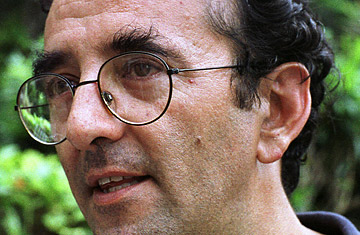
Chilean writer Roberto Bolaño
(2 of 2)
We will not meet our cozy critical clique again. From here 2666 tacks abruptly sideways into the mind of a philosophy professor who teaches in Santa Teresa, and who may be slowly going insane, and then again into another genre entirely, a hard-boiled yarn about a journalist sent to Santa Teresa from New York City to cover a boxing match. It only becomes clear in Part 4 — "The Part about the Crimes" — that Bolaño is performing these lateral leaps the better to observe from all sides what the reader only gradually recognizes as the book's true subject: the horrific serial rape and killing of hundreds of women in and around Santa Teresa. Part 4 consists of a ruthlessly precise forensic catalog of those killings, complete with torn nylons and hematomas and vaginal swabs, mingled together with the stories of the detectives who are working the case and of their principal suspect, an enormous German named Klaus Haas. It is a police procedural straight from the precinct of hell. It is also as bravura a display of novelistic mastery, and as devastating a reading experience, as you are likely ever to encounter. By the time the novelist Archimboldi does show up in Part 5, a belated Godot, we are very far past the possibility of anything resembling a redemptive epiphany. The world of 2666 has been irretrievably shattered.
2666 is not a novel that any responsible critic could describe with words like brisk or taut. (Not like all those other brisk, taut 898-page novels.) That's not Bolaño's method. He's addicted to unsolved mysteries and seemingly extraneous details that actually do turn out to be extraneous, and he loves trotting out characters — indelible thumbnail sketches — whom we will never encounter a second time. If three people spend the night at a hotel, you can count on Bolaño to stop the story cold for 10 pages while he describes each of their dreams. He'll do it gorgeously, but still. This habit can be exhausting. Bolaño is often compared to Jorge Luis Borges, but Borges would never have written 2666. He would have written a short story, an exquisite miniature about a crazy graphomane who talks about writing 2666, and then called it a day.
But the relentless gratuitousness of 2666 has its own logic and its own power, which builds into something overwhelming that hits you all the harder because you don't see it coming. This is a dangerous book, and you can get lost in it. How can art, Bolaño is asking, a medium of form and meaning, reflect a world that is blessed with neither? That is in fact a cesspool of chance and filth? In Part 2 of 2666 the philosophy professor, whose name is Amalfitano, recreates one of Marcel Duchamp's ready-made artworks: he hangs up a geometry textbook outside his house by a string so that the elements can gradually corrupt and destroy its tidy diagrams. He contemplates the book for hours as random, meaningless, non-Euclidean reality invades it, forcing it to register the presence of a world it cannot describe. It is not one of Bolaño's most successful digressions, but it is an excellent metaphor for 2666 itself: "Images with no handhold," the professor says of those ruined pages, "images freighted with all the orphanhood in the world, fragments, fragments." This is the novel corrupted, but its corruption is its salvation, because an orderly book, all signal and no noise, would not be a true book.
There is, of course, something incontrovertibly Bolañoesque about 2666 itself: an enigmatic, unfinished novel, translated from another language, orphaned by its author. The world, whose number Bolaño indisputably had (was it 2666? We never learn), has subtracted Bolaño from the picture, and we must read his work in his absence. But in a tragic, paradoxical way, his death completes the book: it touches 2666 with the disorder and rootlessness that is its subject. And what more could Bolaño have told us anyway? With what final wisdom could he have supplied us? Gazing at his ruined geometry book, Amalfitano fantasizes about meeting a 19th century philosopher on his deathbed and asking him for advice. "What would his response have been?" Amalfitano wonders. "Be happy. Live in the moment. Be good. Or rather: Who are you? What are you doing here? Go away."
